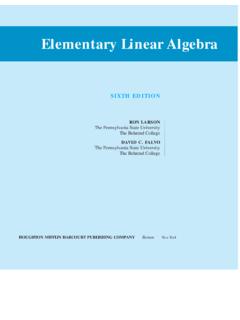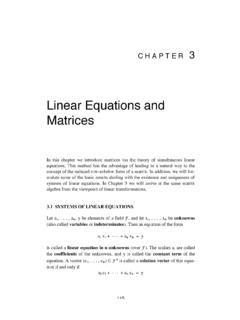Transcription of Schaum's Outline of Linear Algebra
1 schaum SoutlinesLinear AlgebraFourth EditionSeymour Lipschutz, UniversityMarc Lars Lipson, of VirginiaSchaum s Outline SeriesNew York Chicago San Francisco Lisbon London MadridMexico City Milan New Delhi San JuanSeoul Singapore Sydney TorontoSCHAUM SoutlinesCopyright 2009, 2001, 1991, 1968 by The McGraw-Hill Companies, Inc. All rights reserved. Except as permitted under the United States Copyright Act of1976, no part of this publication may be reproduced or distributed in any form or by any means, or stored in a database or retrieval system, without the prior writ-ten permission of the : 978-0-07-154353-8 MHID: 0-07-154353-8 The material in this eBook also appears in the print version of this title: ISBN: 978-0-07-154352-1, MHID: trademarks are trademarks of their respective owners. Rather than put a trademark symbol after every occurrence of a trademarked name, we use names in aneditorial fashion only, and to the benefit of the trademark owner, with no intention of infringement of the trademark.
2 Where such designations appear in this book,they have been printed with initial eBooks are available at special quantity discounts to use as premiums and sales promotions, or for use in corporate training programs. To contacta representative please e-mail us at OF USEThis is a copyrighted work and The McGraw-Hill Companies, Inc. ( McGraw-Hill ) and its licensors reserve all rights in and to the work. Use of this work issubject to these terms. Except as permitted under the Copyright Act of 1976 and the right to store and retrieve one copy of the work, you may not decompile, disassemble, reverse engineer, reproduce, modify, create derivative works based upon, transmit, distribute, disseminate, sell, publish or sublicense the work or anypart of it without McGraw-Hill s prior consent. You may use the work for your own noncommercial and personal use; any other use of the work is strictly prohibited.
3 Your right to use the work may be terminated if you fail to comply with these WORK IS PROVIDED AS IS. McGRAW-HILL AND ITS LICENSORS MAKE NO GUARANTEES OR WARRANTIES AS TO THE ACCURACY,ADEQUACY OR COMPLETENESS OF OR RESULTS TO BE OBTAINED FROM USING THE WORK, INCLUDING ANY INFORMATION THAT CANBE ACCESSED THROUGH THE WORK VIA HYPERLINK OR OTHERWISE, AND EXPRESSLY DISCLAIM ANY WARRANTY, EXPRESS ORIMPLIED, INCLUDING BUT NOT LIMITED TO IMPLIED WARRANTIES OF MERCHANTABILITY OR FITNESS FOR A PARTICULAR and its licensors do not warrant or guarantee that the functions contained in the work will meet your requirements or that its operation will be uninterrupted or error free. Neither McGraw-Hill nor its licensors shall be liable to you or anyone else for any inaccuracy, error or omission, regardless of cause,in the work or for any damages resulting therefrom.
4 McGraw-Hill has no responsibility for the content of any information accessed through the work. Under nocircumstances shall McGraw-Hill and/or its licensors be liable for any indirect, incidental, special, punitive, consequential or similar damages that result from theuse of or inability to use the work, even if any of them has been advised of the possibility of such damages. This limitation of liability shall apply to any claimor cause whatsoever whether such claim or cause arises in contract, tort or Algebra has in recent years become an essential part of the mathematical background required bymathematicians and mathematics teachers, engineers, computer scientists, physicists, economists, andstatisticians, among others. This requirement reflects the importance and wide applications of the book is designed for use as a textbook for a formal course in Linear Algebra or as a supplement to allcurrent standard texts.
5 It aims to present an introduction to Linear Algebra which will be found helpful to allreaders regardless of their fields of specification. More material has been included than can be covered in mostfirst courses. This has been done to make the book more flexible, to provide a useful book of reference, and tostimulate further interest in the chapter begins with clear statements of pertinent definitions, principles, and theorems together withillustrative and other descriptive material. This is followed by graded sets of solved and supplementaryproblems. The solved problems serve to illustrate and amplify the theory, and to provide the repetition of basicprinciples so vital to effective learning. Numerous proofs, especially those of all essential theorems, areincluded among the solved problems. The supplementary problems serve as a complete review of the materialof each first three chapters treat vectors in Euclidean space, matrix Algebra , and systems of Linear chapters provide the motivation and basic computational tools for the abstract investigations of vectorspaces and Linear mappings which follow.
6 After chapters on inner product spaces and orthogonality and ondeterminants, there is a detailed discussion of eigenvalues and eigenvectors giving conditions for representinga Linear operator by a diagonal matrix. This naturally leads to the study of various canonical forms,specifically, the triangular, Jordan, and rational canonical forms. Later chapters cover Linear functions andthe dual spaceV*, and bilinear, quadratic, and Hermitian forms. The last chapter treats Linear operators oninner product main changes in the fourth edition have been in the appendices. First of all, we have expandedAppendix A on the tensor and exterior products of vector spaces where we have now included proofs on theexistence and uniqueness of such products. We also added appendices covering algebraic structures, includingmodules, and polynomials over a field.
7 Appendix D, Odds and Ends, includes the Moore Penrosegeneralized inverse which appears in various applications, such as statistics. There are also many additionalsolved and supplementary , we wish to thank the staff of the McGraw-Hill schaum s Outline Series, especially Charles Wall,for their unfailing page intentionally left blank ContentsCHAPTER 1 Vectors in Rnand Cn, Spatial Introduction Vectors Vector Addition and Scalar Multi-plication Dot (Inner) Product Located Vectors, Hyperplanes, Lines,Curves Vectors inR3(Spatial Vectors),ijkNotation Numbers Vectors inCnCHAPTER 2 Algebra of Introduction Matrices Matrix Addition and Scalar Multiplica-tion Summation Symbol Matrix Multiplication Transpose of aMatrix Square Matrices Powers of Matrices, Polynomials inMatrices Invertible (Nonsingular)
8 Matrices Special Types ofSquare Matrices Complex Matrices Block MatricesCHAPTER 3 Systems of Linear Introduction Basic Definitions, Solutions Equivalent Systems,Elementary Operations Small Square Systems of Linear Equations in Triangular and Echelon Forms Gaussian Elimination Matrices, Row Canonical Form, Row Equivalence GaussianElimination, Matrix Formulation Matrix Equation of a System of LinearEquations Systems of Linear Equations and Linear Combinations ofVectors Homogeneous Systems of Linear Equations ElementaryMatrices 4 Vector Introduction Vector Spaces Examples of Vector Spaces Combinations, Spanning Sets Subspaces Linear Spans, RowSpace of a Matrix Linear Dependence and Independence Basis andDimension Application to Matrices, Rank of a Matrix Sums andDirect Sums CoordinatesCHAPTER 5 Linear Introduction Mappings, Functions Linear Mappings (LinearTransformations) Kernel and Image of a Linear Mapping Singularand Nonsingular Linear Mappings, Isomorphisms Operations withLinear Mappings AlgebraA(V) of Linear OperatorsCHAPTER 6 Linear Mappings and Introduction Matrix Representation of a Linear Operator of Basis Similarity Matrices and General Linear MappingsCHAPTER 7 Inner Product Spaces, Introduction Inner Product Spaces Examples of Inner ProductSpaces Cauchy Schwarz Inequality, Applications Orthogonal-ity Orthogonal Sets and Bases Gram Schmidt OrthogonalizationProcess Orthogonal and Positive Definite Matrices Complex InnerProduct Spaces Normed Vector Spaces (Optional)
9 VCHAPTER 8 Introduction Determinants of Orders 1 and 2 Determinants ofOrder 3 Permutations Determinants of Arbitrary Order Proper-ties of Determinants Minors and Cofactors Evaluation of Determi-nants Classical Adjoint Applications to Linear Equations,Cramer s Rule Submatrices, Minors, Principal Minors BlockMatrices and Determinants Determinants and Volume Determi-nant of a Linear Operator Multilinearity and DeterminantsCHAPTER 9 Diagonalization: Eigenvalues and Introduction Polynomials of Matrices Characteristic Polyno-mial, Cayley Hamilton Theorem Diagonalization, Eigenvalues andEigenvectors Computing Eigenvalues and Eigenvectors, DiagonalizingMatrices Diagonalizing Real Symmetric Matrices and QuadraticForms Minimal Polynomial Characteristic and Minimal Polyno-mials of Block MatricesCHAPTER 10 Canonical Introduction Triangular Form Invariance InvariantDirect-Sum Decompositions Primary Decomposition NilpotentOperators Jordan Canonical Form Cyclic Subspaces Canonical Form Quotient SpacesCHAPTER 11 Linear Functionals and the Dual Introduction Linear Functionals and the Dual Space DualBasis Second Dual Space Annihilators Transpose of aLinear MappingCHAPTER 12 Bilinear, Quadratic.
10 And Hermitian Introduction Bilinear Forms Bilinear Forms andMatrices Alternating Bilinear Forms Symmetric BilinearForms, Quadratic Forms Real Symmetric Bilinear Forms, Law ofInertia Hermitian FormsCHAPTER 13 Linear Operators on Inner Product Introduction Adjoint Operators Analogy BetweenA(V) andC, Special Linear Operators Self-Adjoint Operators Orthogonaland Unitary Operators Orthogonal and Unitary Matrices Changeof Orthonormal Basis Positive Definite and Positive Operators and Canonical Forms in Inner Product Spaces TheoremAPPENDIX A Multilinear Products396 APPENDIX B Algebraic Structures403 APPENDIX C Polynomials over a Field411 APPENDIX D Odds and Ends415 List of Symbols420 Index421viContentsCHAPTER 1 Vectors in Rnand Cn,Spatial IntroductionThere are two ways to motivate the notion of a vector: one is by means of lists of numbers and subscripts,and the other is by means of certain objects in physics.





